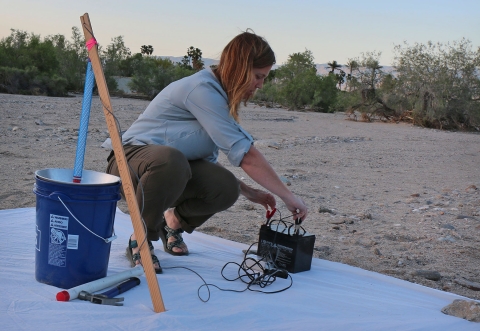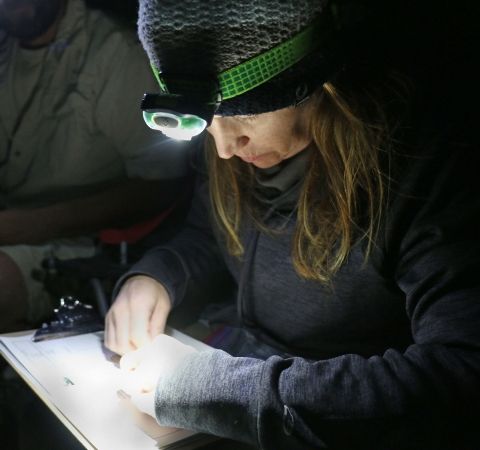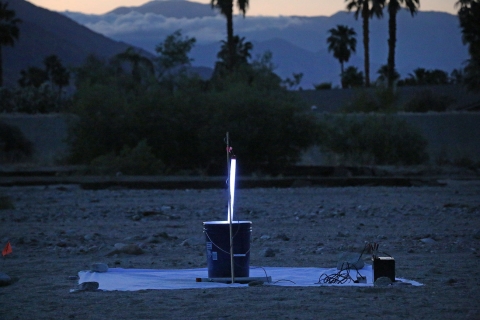The Casey’s June beetle lives in and near a 3.5 mile stretch of the Palm Canyon Wash in Palm Springs, Calif., and nowhere else on earth.
A secretive, slightly fuzzy insect that spends almost all of its life underground, the beetle was listed as endangered under the Endangered Species Act in 2011, due to a loss of 96 percent of its habitat.
U.S. Fish and Wildlife Service biologists Noelle Ronan and Chris Gregory have set out on a quest to research the population size and natural history of this beetle, which Noelle describes as “fascinating and pretty cool.”
Until now, no population estimates have been attempted and biologists had minimal information on the species, in large part due to the beetle’s mysterious underground lifestyle. Chris and Noelle’s range wide study of the Casey’s June beetle population aims to fill this knowledge gap.
The Casey’s June beetle spends a majority of its life underground and only briefly emerges to mate during the spring — a few minutes for the flightless females and a few hours for the flying males.
Noelle and Chris believe that environmental conditions may control the start date and duration of the beetle’s breeding season, which include parts of April and May - a tight timeline for the population survey.
Information gathered through the survey will help the Service understand the current status of the beetle and develop and maximize recovery strategies for it. The study was funded in late 2014 and by the Spring of 2015, biologists began mapping vegetation, surveying for emergence holes, testing methods for monitoring soil temperatures, and setting up survey plots range wide.
In 2016, with the help of local volunteers, range wide surveying began in earnest and the scope of work increased.
“Last year we had about 30 volunteers. This year, we’ve added 45 more volunteers and more people are interested all the time,” Chris explained. “During the range-wide surveys, we have 16 sites set up, with at least two volunteers each."
"It’s humbling to know that we have so many people from the surrounding area who want to help us learn more about this secretive insect," he said. "The volunteers are pretty excited when they find one of these little guys, and I think that’s the most rewarding part for them."
"We wouldn’t be able to do the range wide survey without volunteers,” he said.
In addition to the range wide surveys, Noelle and Chris dedicate several evenings per week to finding beetles at a single sentinel site during the Casey’s June beetle mating season.
For the third night that week, Noelle and Chris diligently show up at the Palm Springs Wash at the sentinel site with survey tools in-hand to search for beetles. The survey starts prior to sun-down and continues into the evening to take advantage of the male beetles’ attraction to black lights.
They set up camp within five minutes (they’re clearly pros). Then, they record the weather conditions, such as wind speed, as well as soil and air temperatures, at regular intervals throughout the survey with tools called environmental meters.
On this night, conditions are not ideal for finding beetles, the wind is a little high and the temperature a bit brisk for their liking.
Next, they wait for it to get dark enough for the black lights to attract the beetles. For an hour and a half, while the sun sets behind the mountains and the black light slowly illuminates the wash, Noelle and Chris search the area for evidence of beetle emergence since the previous survey, as well as predators taking advantage of this seasonal food source.
As darkness falls, moths replace hummingbirds as the primary pollinator gathering nectar from nearby flowers, bats and nighthawks emerge, and a Cooper’s hawk lands nearby.
Exactly an hour after sunset, with headlamps in place, it is finally time to check for beetles. The reward for a slightly windy and cold evening in the desert: a single Casey’s June beetle.
“Awesome, at least we got one. I wasn’t sure if we would find any with the current conditions," Chris said.
“Our standing record at the sentinel site is 62 beetles captured within an hour using the same set-up we used here, but it is possible to capture hundreds with a stronger, brighter light and the right environmental conditions,” he added.
Noelle processed the beetle while Chris recorded the measurements and made sure there was enough light at the site.
Processing involves marking each beetle with a unique number and color combination, in this instance, red and number 18, then taking its body measurements.
They’ve found that most adult male Casey’s June beetles are between 1.4 to 1.8 cm in length, 0.7 to 0.8 cm in width, roughly the size of a dime.
“Initially, most beetles are calm and tolerant of this process. After a few minutes, you can tell they’re ready to go back to finding a mate,” Noelle said as she released the beetle back into the sandy gravel. Then, "Number 18" quickly flew away.
For the next nine months, Noelle and Chris will periodically return to the Palm Canyon Wash to survey vegetation, habitat, emergence holes and subsurface development of larval Casey’s June beetles with the help of the volunteers.
Data will be reviewed, analyzed, and then the whole process will begin again for the next mating season. The research project will continue through mid-2018. The first product of this research, a collaborative genetics study with the University of Hawaii, will be finished later this year.











